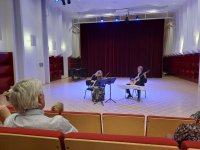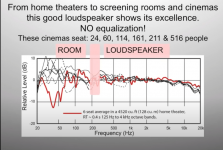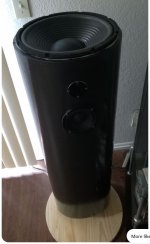I will try to find it. Have you watched any ASR YouTube videosok i get it...pseudo science is still science....and it doesn't require corroboration...it has to be right after all your source is something posted on the internet!!
not sure I follow the second paragraphWhat sort? I like things to be dead early on... After that it's good to have a reverberant field.
This is hard to do if you over treat your room, and so it requires appropriately designed speakers of which many are DIY designs.
if a well designed wide dispersion direct radiator speaker is designed to be be flat in anechoic chamber or free field space and then played back in a near similar space then we should hear exactly what is in the recording and without room influence? A window into the recording space.
Yes, but the reverberant field would be missing. That reverberation includes the ambience of your room but it is separated in time enough so it is beneficial rather than fatiguing. It doesn't confuse the original venue ambience which is dominant.
This takes a speaker that doesn't require that you treat the room very much, at least beyond a minimum that might be used to further reduce early reflections.
This takes a speaker that doesn't require that you treat the room very much, at least beyond a minimum that might be used to further reduce early reflections.
I disagree with this statement unless the speaker is not cooperating with the room/our hearing.We can hear through the room but the the room still adds a disturbing/ disruptive quality.
Just consider whether you'd rather listen to an orchestra in a concert hall or open field. I think I know what at LEAST 80% of people would rather, and wouldn't be surprised if it was more like 95%+ (there's always some people with questionable taste!)thank you.
Live un-amplified song and music instruments in halls have given me best sound. Amplified live music in same halls have given me worst sound!
Loudspeakers and stereo must have some reflections and reverberance, but only some! Multiway room must have minimal RT.
Loudspeakers and stereo must have some reflections and reverberance, but only some! Multiway room must have minimal RT.
Attachments
from Floyd’s video after 20 minutes he is saying that the most important sound is the direct sound for accuracy in timbre. We can hear through the room but the the room still adds a disturbing/ disruptive quality.
I agree with @AllenB and like the room to be dead at first. I'd rather listen to David Griesinger when it comes to room behavior.
Even though much of his research was about halls, he does translate it to rooms quite often in his speeches and papers.
A hint of reverb arriving from lateral angles and timed much later than what Toole advertises works quite well for me.
Natural sounding, spacious and enveloping. While keeping the clarity and focus in imaging.
Agreed. For example in my room if I can get the early reflections to hold off until beyond the listening depth, then reverberation will tend to be spread starting near 30ms behind the direct.
This doesn't take effort to hear as separate, especially when the whole field sounds the same as the direct sound. I might venture that it lends the instinctive comfort of being able to sense your surroundings, without actually affecting the music.
This doesn't take effort to hear as separate, especially when the whole field sounds the same as the direct sound. I might venture that it lends the instinctive comfort of being able to sense your surroundings, without actually affecting the music.
Hall or open field, it's where ever the concert is taking place and its all good.Just consider whether you'd rather listen to an orchestra in a concert hall or open field. I think I know what at LEAST 80% of people would rather, and wouldn't be surprised if it was more like 95%+ (there's always some people with questionable taste!)
well, not really. I'd prefer an open field over some indoor venues with horribly delayed ambient effects like Massey Hall or Roy Thompson hall. I've been to Massey hall at least 25 times for music shows and was never impressed or comfortable with the ambient soundscape at the more distant seats. Stephane Grappelli's direct sound was almost lower than the loud ambient soup.
When Massey Hall was built in 1894, it was designed to sound pristine without amplification, and its legendary acoustics are both a feature and a bug
Acoustical Renovation of Roy Thomson Hall ... In 2002, the auditorium underwent a $20+ million acoustical reengineering altering its size, design...
Ethan Winer pushes for a well damped listening room and I adopted this and haven't been disappointed in my last home which is now being enjoyed by a guitar player. Well damped room for music practise is not a bad thing either. Recording is a different story
One criteria for the room I'm working on is that all treatments are built into the walls so this plan means 100% broadband absorption(fabric covered) and this being good for the most bass control as possible. I suppose a reverberant field can be created later through wall and table objects or some natural wood diffusers as I find them attractive. experimenting can come after wall treatment installation!
One criteria for the room I'm working on is that all treatments are built into the walls so this plan means 100% broadband absorption(fabric covered) and this being good for the most bass control as possible. I suppose a reverberant field can be created later through wall and table objects or some natural wood diffusers as I find them attractive. experimenting can come after wall treatment installation!
If I understand the presentation at the end correctly, where he shows the overall response example of "room" (lower freq) transitioning to "speaker" (higher freq) - it appears the all-important vocal range is in the middle of that transition. So the room certainly affects the vocals also?Around between 4min to 17 min in this video, the science on sighted vs blind listening is shown. Nothing new here, but
in my mind it tells the broad story of better measured designs are better sound for the majority of Humans. It is meaningless when inexperienced persons say they have heard the best sound from speaker or system X, while criticising a clearly better measured system.
The entire video is worth watching at least twice!
Here's an interesting post from Frank Malitz from Quora (long time in the audio industry):
Why do different speakers (drivers) that have the same size, ratings, and frequency responses sound different from each other?
This is one of the best questions I have seen on this forum. As an industry veteran of 55 years and a loudspeaker manufacturer myself, we’ve never been able to correlate the measurements with the actual performance accurately.
As a result, speakers with almost identical measurements sound completely different at times. Even within the same brand, it’s difficult to develop a family sound.
As long as the engineers rely on numbers, our progress is going to be very slow. It’s Half physics and half art. There are no perfect Loudspeakers. So, simply put, we lack the science.
Why do different speakers (drivers) that have the same size, ratings, and frequency responses sound different from each other?
This is one of the best questions I have seen on this forum. As an industry veteran of 55 years and a loudspeaker manufacturer myself, we’ve never been able to correlate the measurements with the actual performance accurately.
As a result, speakers with almost identical measurements sound completely different at times. Even within the same brand, it’s difficult to develop a family sound.
As long as the engineers rely on numbers, our progress is going to be very slow. It’s Half physics and half art. There are no perfect Loudspeakers. So, simply put, we lack the science.
https://projectgallery.parts-express.com/home-audio-video/eliasound-m1/
this is cool.
mounting a speaker to a tall cylinder.
Not as good as a ball, but I would think really good.
Probably make it 6' tall so as not to worry about diffraction.
Think I would do same but as a satellite with a separate bass module.
12" pvc......................
I found 12" x 5' long shedule 40 pvc for $273.
Baffle step at 4560/12 = 380hz, maybe 3-6db down depending on room / distance to front wall, etc.
down even more at 190hz also.
I think patrick bateman said something about doing something similar and it sounding really good.
this is cool.
mounting a speaker to a tall cylinder.
Not as good as a ball, but I would think really good.
Probably make it 6' tall so as not to worry about diffraction.
Think I would do same but as a satellite with a separate bass module.
12" pvc......................
I found 12" x 5' long shedule 40 pvc for $273.
Baffle step at 4560/12 = 380hz, maybe 3-6db down depending on room / distance to front wall, etc.
down even more at 190hz also.
I think patrick bateman said something about doing something similar and it sounding really good.
Attachments
Last edited:
sound propagates to all directions so its only matter of wavelength and distances what the combined response is at listening position. If we want booty shaking bass we dont have to install it to the bootMaybe a down firing woofer so stuff is not bouncing off the ceiling and you get some floor shaking bass
- Home
- Loudspeakers
- Multi-Way
- What are some good example of baffle design to improve diffraction


